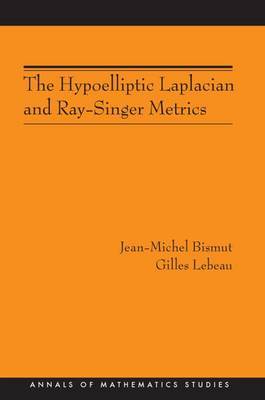Annals of Mathematics Studies
2 primary works
Book 167
The Hypoelliptic Laplacian and Ray-Singer Metrics. (AM-167)
by Jean-Michel Bismut and Gilles Lebeau
Published 1 January 2008
This book presents the analytic foundations to the theory of the hypoelliptic Laplacian. The hypoelliptic Laplacian, a second-order operator acting on the cotangent bundle of a compact manifold, is supposed to interpolate between the classical Laplacian and the geodesic flow. Jean-Michel Bismut and Gilles Lebeau establish the basic functional analytic properties of this operator, which is also studied from the perspective of local index theory and analytic torsion. The book shows that the hypoelliptic Laplacian provides a geometric version of the Fokker-Planck equations.The authors give the proper functional analytic setting in order to study this operator and develop a pseudodifferential calculus, which provides estimates on the hypoelliptic Laplacian's resolvent. When the deformation parameter tends to zero, the hypoelliptic Laplacian converges to the standard Hodge Laplacian of the base by a collapsing argument in which the fibers of the cotangent bundle collapse to a point. For the local index theory, small time asymptotics for the supertrace of the associated heat kernel are obtained.
The Ray-Singer analytic torsion of the hypoelliptic Laplacian as well as the associated Ray-Singer metrics on the determinant of the cohomology are studied in an equivariant setting, resulting in a key comparison formula between the elliptic and hypoelliptic analytic torsions.
The Ray-Singer analytic torsion of the hypoelliptic Laplacian as well as the associated Ray-Singer metrics on the determinant of the cohomology are studied in an equivariant setting, resulting in a key comparison formula between the elliptic and hypoelliptic analytic torsions.
Book 177
Hypoelliptic Laplacian and Orbital Integrals (Am-177)
by Jean-Michel Bismut
Published 1 January 2011
This book uses the hypoelliptic Laplacian to evaluate semisimple orbital integrals in a formalism that unifies index theory and the trace formula. The hypoelliptic Laplacian is a family of operators that is supposed to interpolate between the ordinary Laplacian and the geodesic flow. It is essentially the weighted sum of a harmonic oscillator along the fiber of the tangent bundle, and of the generator of the geodesic flow. In this book, semisimple orbital integrals associated with the heat kernel of the Casimir operator are shown to be invariant under a suitable hypoelliptic deformation, which is constructed using the Dirac operator of Kostant. Their explicit evaluation is obtained by localization on geodesics in the symmetric space, in a formula closely related to the Atiyah-Bott fixed point formulas. Orbital integrals associated with the wave kernel are also computed. Estimates on the hypoelliptic heat kernel play a key role in the proofs, and are obtained by combining analytic, geometric, and probabilistic techniques.
Analytic techniques emphasize the wavelike aspects of the hypoelliptic heat kernel, while geometrical considerations are needed to obtain proper control of the hypoelliptic heat kernel, especially in the localization process near the geodesics. Probabilistic techniques are especially relevant, because underlying the hypoelliptic deformation is a deformation of dynamical systems on the symmetric space, which interpolates between Brownian motion and the geodesic flow. The Malliavin calculus is used at critical stages of the proof.
Analytic techniques emphasize the wavelike aspects of the hypoelliptic heat kernel, while geometrical considerations are needed to obtain proper control of the hypoelliptic heat kernel, especially in the localization process near the geodesics. Probabilistic techniques are especially relevant, because underlying the hypoelliptic deformation is a deformation of dynamical systems on the symmetric space, which interpolates between Brownian motion and the geodesic flow. The Malliavin calculus is used at critical stages of the proof.

